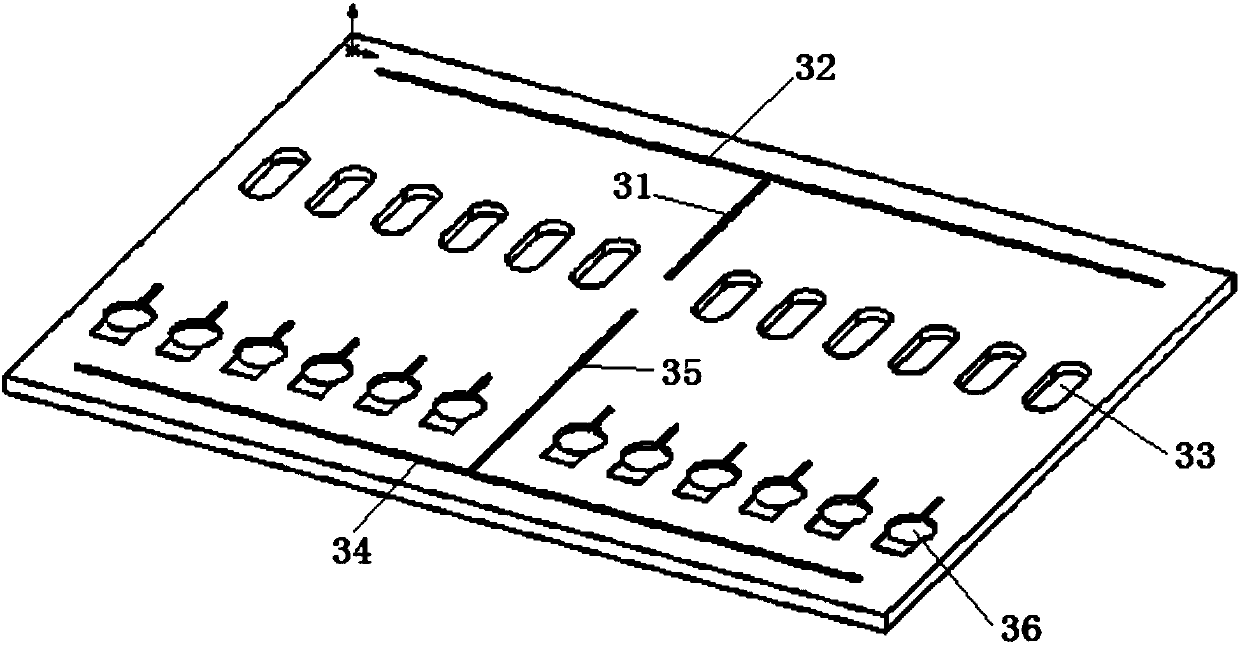Micro-fluidic chip reagent kit for detecting ten respiratory tract infection pathogens and use method of reagent kit
A microfluidic chip, respiratory technology, applied in the field of molecular biology, can solve the problems of low sensitivity, inconvenient operation, poor culture effect, etc., and achieve the effect of strong specificity
- Summary
- Abstract
- Description
- Claims
- Application Information
AI Technical Summary
Problems solved by technology
Method used
Image
Examples
Embodiment 1
[0130] Microfluidic chip detection kit for detecting 10 kinds of respiratory infection pathogens, the kit is composed of primer-probe mixture, RT-PCR buffer, mixed enzyme solution, positive quality control and RNase-free water; RT-PCR buffer includes PCR buffer, dATP, dUTP, dCTP, dGTP, and MgCl 2 ; The mixed enzyme solution includes HotStart Taq enzyme, reverse transcriptase and UNG enzyme; the positive quality control contains plasmids corresponding to the amplified gene sequences of the above 10 respiratory pathogens.
[0131] The final concentration of the primer in the amplification system is 100-1000nM; the final concentration of the probe in the amplification system is 50-500nM.
[0132] Kit operation and result determination
[0133] (1) Dilute 50 μL of sample DNA / RNA co-extraction template (extracted from human sputum, throat swab, etc.) with RNase-free water to 500 μL into the sample well of the chip, and mix with the pre-loaded mixed enzyme in the sample well solut...
Embodiment 2
[0140] 15 samples were tested with a microfluidic chip, 5 negative samples were numbered 1 to 5, and 10 positive samples were numbered 6 to 15 containing the nucleic acids of 10 positive strains of pathogens respectively. Sample No. 6 contained Mycoplasma pneumoniae nucleic acid, and Sample No. 7 contained pneumonia Chlamydia nucleic acid, sample No. 8 contained Legionella pneumophila nucleic acid, sample No. 9 contained Bacillus pertussis nucleic acid, sample No. 10 contained rhinovirus nucleic acid, sample No. 11 contained respiratory adenovirus nucleic acid, sample No. 12 contained influenza A virus nucleic acid, and No. 13 Samples contained influenza B virus nucleic acid, sample No. 14 contained respiratory syncytial virus nucleic acid, and sample No. 15 contained parainfluenza virus nucleic acid. The detection operation was carried out according to the same method as in Example 1, and the detection results are shown in Table 1.
[0141] Table 1
[0142]
[0143]
...
Embodiment 3
[0146] Use the microfluidic chip to detect ten kinds of pathogenic plasmid mixed samples respectively, according to the dilution concentration of 10 5 copies / μL, 10 4 copies / μL, 10 3 copies / μL, 10 2 Sensitivity test was carried out with five gradients of copies / μL and 10copies / μL. Detection was carried out in the same manner as in Example 1.
[0147] The test results show that the kit of the present invention has good sensitivity in the microfluidic chip, and the Ct value changes in a gradient as the concentration decreases. The results are shown in Table 2.
[0148] Table 2
[0149]
[0150]
[0151] The test results show that the kit is effective against respiratory pathogens Mycoplasma pneumoniae, Chlamydia pneumoniae, Legionella pneumophila, Bordetella pertussis, rhinovirus, influenza A virus, influenza B virus, respiratory adenovirus, syncytial virus, The diagnosis of parainfluenza virus is highly sensitive, and the detection sensitivity of each item can reach ...
PUM
 Login to View More
Login to View More Abstract
Description
Claims
Application Information
 Login to View More
Login to View More - R&D Engineer
- R&D Manager
- IP Professional
- Industry Leading Data Capabilities
- Powerful AI technology
- Patent DNA Extraction
Browse by: Latest US Patents, China's latest patents, Technical Efficacy Thesaurus, Application Domain, Technology Topic, Popular Technical Reports.
© 2024 PatSnap. All rights reserved.Legal|Privacy policy|Modern Slavery Act Transparency Statement|Sitemap|About US| Contact US: help@patsnap.com










